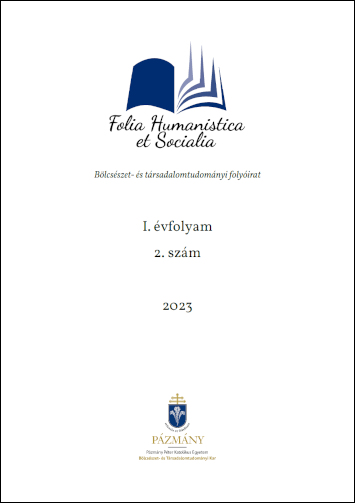Esther Greenwood as the ’Mad Woman’: The Connection between Patriarchy, Femininity and Stigmatized Female Mental Illness in Sylvia Plath’s The Bell Jar
Published 31-12-2023 — Updated on 11-06-2024
Copyright (c) 2023 Tóth Tamara

This work is licensed under a Creative Commons Attribution 4.0 International License.
Abstract
This article argues that Sylvia Plath's The Bell Jar highlights systemic problems and ideologies that defined American society in the 1950s and 1960s, contributing to gender inequality. Many of the social issues that the novel explores are still present in Western cultures today, and therefore the work can be understood as the representation of not only subjective, but a universal female experience. The journey of Plath’s heroine, Esther Greenwood, leads through anxiety, depression, a suicide attempt and shock therapy to her recovery. The novel details the surrounding factors that negatively affect her mental health. The aim of the article is to analyze Esther's story by examining the ideals that perpetuate an unequal system that stigmatizes female sexuality, self-determination and mental illness, and dismisses female experience, thereby highlighting the link between mental illness and social oppression.
References
- Birmingham Feminist History Group. (2005). Feminism as Femininity in the Nineteen Fifties? Feminist Review, 80, 6–23. https://www.jstor.org/stable/3874362
- Coyle, S. (1984). Images of Madness and Retrieval: An Exploration of Metaphor in The Bell Jar. Studies in American Fiction, 12 (2), 161-174. https://doi.org/10.1353/saf.1984.0027
- Dowbnia, R. (2014) Consuming Appetites: Food, Sex, and Freedom in Sylvia Plath’s The Bell Jar. Women’s Studies, 43(5), 567-588. https://doi.org/10.1080/004978878.2014.914392
- Espinosa, M. (2021). The Male Gaze and Intersectionality in The Bell Jar by Sylvia Plath and The Handmaid’s Tale by Margaret Atwood. [Honors Thesis]. Florida State University Libraries.
- Friedan, B. (1963). The Feminine Mystique. W. W. Norton.
- Ghandeharion, A. (2015). Sylvia Plath’s The Bell Jar: a Mirror of American Fifties. A Biannual Publication on the Study of Language and Literature, 17(2), 64-70. https://doi.org/10.9744/kata.17.2.64-70
- Millett, K. (1970). Sexual Politics. Doubleday.
- Möller, F. (2002). Inventing Madness: A Feminist Reading of Sylvia Plath's The Bell Jar and Susanna Kaysen's Girl, Interrupted. [Master’s degree]. Högskolan i Halmstad.
- Moi, T. (1985). Sexual/Textual Politics. Meuthen & Co. Ltd.
- Morantz-Sanchez, R. (1987) Consolidating the Spheres: Exploring the History of Twentieth Century American Women. Reviews in American History, 15(4), 674–79. https://doi.org/10.2307/2701948
- Mulvey, L. (1975). Visual Pleasure and Narrative Cinema. Screen, 16(3), 6– 18. https://dx.doi.org/10.1093/screen/16.3.6
- Noriko, M. (2018). Feminine Failure and the Modern Hero: Mad Women in Sylvia Plath’s The Bell Jar and Joan Didion’s Play It As It Lays. Review of Japanese Culture and Society, 30, 71–83. https://doi.org/10.1353/roj.2018.0005
- Paley, F. Y. (2019). Stressed, Depressed, and Sexually Repressed: Patriarchy and Depression in The Bell Jar. [Honors Thesis]. Stern College for Women, Yeshiva University.
- Perloff, M. G. & Plath, S. (1972). A Ritual for Being Born Twice: Sylvia Plath’s ‘The Bell Jar.’ Contemporary Literature, 13(4), 507–22. https://doi.org/10.2307/1207445
- Plath, S. (1963). The Bell Jar. Heinemann.
- Sakane, Y. (1998). The Mother, the Self, and the Other: The Search for Identity in Sylvia Plath’s ‘The Bell Jar’ and Takahashi Takako’s ‘Congruent Figure.’ U.S.-Japan Women’s Journal, 14, 27–48. https://www.jstor.org/stable/42772124
- Showalter, E. (1992). Killing the Angel in the House: The Autonomy of Women Writers. The Antioch Review, 50(1/2), 207–20. https://doi.org/10.2307/4612511
- Skomp, E. (2003) Misogyny, the Male Gaze, and Fantasies of Female Death: ‘Eto Ia, Edichka and Russkaia Krasavitsa. New Zealand Slavonic Journal, pp. 137–42. https://www.jstor.org/stable/40922148
- Séllei, N. (2003). The Fig Tree and the Black Patent Leather Shoes: The Body and its Representation in Sylvia Plath’s ‘The Bell Jar.’ Hungarian Journal of English and American Studies (HJEAS), 9(2), 127–54. https://dx.doi.org/10.2307/41274242
- Woolf, V. (2021). The Death of the Moth and Other Essays. Rare Treasure Editions. Kindle Edition.
- Whittier, G. (1976) The Divided Woman and Generic Doubleness in ’The Bell Jar.’ Women's Studies, 3(2), 127-146. https://doi.org/10.1080/00497878.1976.9978383

